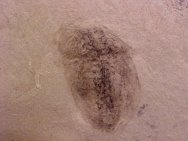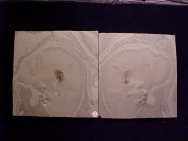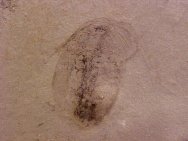Naraoia sp.
Family Naraoiidae, Soft-bodied Arthropod); having resemblance to Naraoia compacta from the Burgess Shale
Geologic Time: Middle Cambrian Utah Cambrian Explosion Fossil
Size: inches (25.4mm=1 inch): Specimen 20mm in matrix 75mm X 80mm
Fossil Site: Marjum Formation, Millard County, Utah
|
The prevailing view is that the Nectaspida are a sister group to the clade which includes the calcified trilobites. The revised Treatise adopts the tactic of treating the naraoiids as a family within the class Trilobita, order "uncertain," thereby acknowledging a systematic position within the class, but allowing the formal definition of Trilobita to be based upon the characters of calcified forms (Fortey 1997, p. 294). For your further study:
Gould wrote: "Even if complexity is only a drift away from a constraining left wall, we might view trends in this direction as more predictable and characteristic of life's pathway as a whole if increments of complexity accrued in a persistent and gradually accumulating manner through time. But nothing about life's history is more peculiar with to this common (and false) respect expectation than the actual pattern of extended stability and rapid episodic movement, as revealed by the fossil record." |


